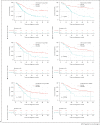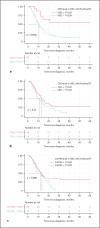Serum Biomarker Status with a Distinctive Pattern in Prognosis of Gastroenteropancreatic Neuroendocrine Carcinoma
- PMID: 34592743
- PMCID: PMC9533446
- DOI: 10.1159/000519948
Serum Biomarker Status with a Distinctive Pattern in Prognosis of Gastroenteropancreatic Neuroendocrine Carcinoma
Abstract
Objective: Gastroenteropancreatic neuroendocrine carcinoma (GEPNEC) is a major research focus, but the application of biomarkers to guide its prognostication and management is unsatisfying. Clinical values of conventional serum biomarkers, neuron-specific enolase (NSE), carcinoembryonic antigen (CEA), and carbohydrate antigen 19-9 (CA199) warrant scrutiny.
Methods: Patients diagnosed with GEPNEC with baseline NSE, CEA, and CA199 levels provided in Peking University Cancer Hospital were retrospectively studied. Relationships between biomarkers and prognosis were investigated by the χ2 test, Kaplan-Meier analysis, and univariate and multivariate Cox regression analyses.
Results: A total of 640 GEPNEC patients were enrolled. NSE, CEA, and CA199 were elevated in 59.5%, 28.5%, and 21.3% of the population, respectively. Higher NSE had worse median overall survival (OS) (17.0 months vs. not reached, hazard ratio = 2.77 [2.06, 3.73], p < 0.001), and so did patients with higher CEA and CA199. Multivariable analysis confirmed that NSE and CA199 correlated with OS independently. Baseline NSE level and NSE remission predicted OS and the response of patients with first-line etoposide plus cisplatin (EP) treatment. Furthermore, we combined NSE/CEA/CA199 to segregate GEPNEC into novel subgroups, namely, adenocarcinoma-like NEC (ALN), neuroendocrine-like NEC (NLN), and triple-normal NEC (TNN). The groups shared distinctive clinicopathologic features and prognosis (21.0 months vs. 17.1 months vs. not reached, p < 0.001). The EP regimen remained the priority treatment option in NLN/TNN, while ALN was predisposed to "adenocarcinoma-like chemotherapy."
Conclusions: Elevation of NSE, CEA, or CA199 was common and independently indicates poor prognosis in GEPNEC patients. Serum biomarker-based subtypes suggest meaningful clinical implications and appropriate therapeutic approaches, illuminating promising ways to characterize the prognosis of GEPNEC.
Keywords: Biomarkers; Carbohydrate antigen 19-9; Carcinoembryonic antigen; Gastroenteropancreatic neuroendocrine carcinoma; Neuron-specific enolase; Overall survival; Subtype.
© 2021 The Author(s). Published by S. Karger AG, Basel.
Conflict of interest statement
We have read and understood the policy on disclosing conflicts of interest and have no conflicts of interest to declare.
Figures



Similar articles
-
[Prognostic value of carcinoembryonic antigen, alpha fetoprotein, carbohydrate antigen 125 and carbohydrate antigen 19-9 in gastroenteropancreatic neuroendocrine neoplasms].Zhonghua Wei Chang Wai Ke Za Zhi. 2017 Sep 25;20(9):1002-1008. Zhonghua Wei Chang Wai Ke Za Zhi. 2017. PMID: 28900990 Chinese.
-
Prognostic Value of Pretreatment Serum CA199 in Patients with Locally Advanced Rectal Cancer Treated with CRT Followed by TME with Normal Pretreatment Carcinoembryonic Antigen Levels.Dig Surg. 2021;38(1):24-29. doi: 10.1159/000508442. Epub 2020 Nov 10. Dig Surg. 2021. PMID: 33171467
-
Combining serum calcitonin, carcinoembryonic antigen, and neuron-specific enolase to predict lateral lymph node metastasis in medullary thyroid carcinoma.J Clin Lab Anal. 2020 Jul;34(7):e23278. doi: 10.1002/jcla.23278. Epub 2020 Mar 6. J Clin Lab Anal. 2020. PMID: 32141647 Free PMC article.
-
History, molecular features, and clinical importance of conventional serum biomarkers in lung cancer.Surg Today. 2017 Sep;47(9):1037-1059. doi: 10.1007/s00595-017-1477-y. Epub 2017 Feb 22. Surg Today. 2017. PMID: 28229299 Review.
-
Growth differentiation factor-15 may be a novel biomarker in pancreatic cancer: A review.Medicine (Baltimore). 2024 Feb 9;103(6):e36594. doi: 10.1097/MD.0000000000036594. Medicine (Baltimore). 2024. PMID: 38335385 Free PMC article. Review.
Cited by
-
Development of a MVI associated HCC prognostic model through single cell transcriptomic analysis and 101 machine learning algorithms.Sci Rep. 2025 Mar 7;15(1):7977. doi: 10.1038/s41598-025-91475-1. Sci Rep. 2025. PMID: 40055377 Free PMC article.
-
A Rare Case of Brain Metastasis of Gastric Neuroendocrine Carcinoma.Cureus. 2025 May 3;17(5):e83417. doi: 10.7759/cureus.83417. eCollection 2025 May. Cureus. 2025. PMID: 40462826 Free PMC article.
-
Beyond ENO1, emerging roles and targeting strategies of other enolases in cancers.Mol Ther Oncolytics. 2023 Nov 10;31:100750. doi: 10.1016/j.omto.2023.100750. eCollection 2023 Dec 19. Mol Ther Oncolytics. 2023. PMID: 38075246 Free PMC article. Review.
References
-
- Yao JC, Hassan M, Phan A, Dagohoy C, Leary C, Mares JE, et al. One hundred years after “Carcinoid”: epidemiology of and prognostic factors for neuroendocrine tumors in 35,825 cases in the United States. J Clin Oncol. 2008 Jun 20;26((18)):3063–72. - PubMed
-
- Walter T, Tougeron D, Baudin E, Le Malicot K, Lecomte T, Malka D, et al. Poorly differentiated gastro-entero-pancreatic neuroendocrine carcinomas: are they really heterogeneous? insights from the FFCD-GTE national cohort. Eur J Cancer. 2017 Jul;79:158–65. - PubMed
-
- Sorbye H, Baudin E, Borbath I, Caplin M, Chen J, Cwikla JB, et al. Unmet needs in high-grade gastroenteropancreatic neuroendocrine neoplasms (WHO G3) Neuroendocrinol. 2019;108((1)):54–62. - PubMed
Publication types
MeSH terms
Substances
LinkOut - more resources
Full Text Sources
Other Literature Sources
Medical

